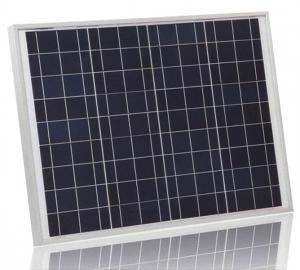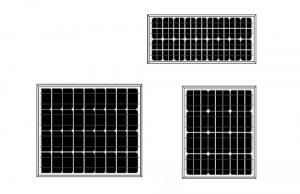High Efficiency Good Quality Solar Panels from China Manufacturers
- Loading Port:
- Shanghai
- Payment Terms:
- TT OR LC
- Min Order Qty:
- 2500 watt
- Supply Capability:
- 15000 watt/month
OKorder Service Pledge
OKorder Financial Service
You Might Also Like
Specification
Product Description:
1. Structure of Polycrystalline Silicon Solar Panel Type CR290P-CR250P
Solar modules, which are widely used in ground mounted utility-scale PV plants, large-scale and small civil and commercial power generating system such as BIPV combined to the grid, roof-mounted PV power system, rural electrification, communications, emergency auxiliary power.
Solar PV module is comprised of some solar cells which are connected in serial with high efficiency and enhanced reliability.
2. Standard Test Conditions of Monocrystalline Silicon Solar Panel:
The opto-electrical specifications shown below are stabilized values being measured at Standard Test Conditions, Irradiance: 1000W/m2, Spectrum: AM1.5 at 25°C, The info below is subject to manufacturing tolerances. Where appropriate minutes of measurement are available and are used for the dimensioning of the installation.
Advantages of Monocrystalline Silicon Solar Panel
• CNBM Solar performance guarantees for 25 years
• 12 years guarantee for workmanship
• Timeliness of delivery
• Quality Products certified (TÜV, UL, CE, ISO)

PERFORMANCE
- High effi ciency, multicrystalline silicon solar cells with high transmission and textured glass deliver a module effi ciency of up to 16.0%,
minimizing installation costs and maximizing the kWh output of your system per unit area.
- Tight positive power tolerance of 0W to +5W ensures you receive modules at or above nameplate power and contributes to minimizing
module mismatch losses leading to improved system yield.
FAQ
We have organized several common questions for our clients,may help you sincerely:
①What price for each watt?
It depends on the quantity, delivery date and payment terms,
②What is your size for each module? Can you tell me the Parameter of your module?
We have different series of panels in different output, both c-Si and a-Si. Please take the specification sheet for your reference.
③Can you provide the peripheral products of the solar panels, such as the battery, controller, and inverter? If so, can you tell me how do they match each other?
Yes, we can, we have two companies for solar region, one is CNBM International, the other is CNBM engineering Co.
We can provide you not only the solar module but also the off grid solar system, we can also provide you service with on grid plant.
④What is your warranty system?
Our product performance guarantees for 25 years
• 12 years guarantee for workmanship
• Timeliness of delivery
• Quality Products certified (TÜV, UL, CE, ISO)
- Q: Rooftop solar panel (not sure if rubber or plastic?) has leak arising from thin vertical crack in panel about long. Any ideas for repair?Thanks.
- Depending on the material and operating temperature of the panel, it MAY be possible to fix it very simply and easily by applying Hot Glue Gun adhesive over the cracked area. The high temperature glue gun adhesive melts at approximately 60 degrees Farenheit, and if the collector temperature does not quite reach, or exceed that operating temperature, then that repair method should work. Another possibility is an aerosol spray can product called LeakEnder. This is usually available at your local hardware store, or the major home improvement centers [like Lowe's, Sutherland's, Home Depot, McCoy's, etc.]. After preparing the area to be patched by cleaning, you just spray the LeakEnder patching material on the crack and an eighth of an inch or so around. IF the operating pressure or the collector is very low, it MAY even be possible to patch the leak with nothing more than a narrow strip of DUCT TAPE!!!!! Another possibility, but unless carefully accomplished is to weld the crack with a Soldering Gun and some scrap plastic from packaging material. The problem with this fix is that you must be very experienced in application of heat from the Soldering Gun, OR you will melt a larger hole in the collector tube than the crack was. Regardless of patching method, it is CRITICAL that the cracked area to be patched MUST be CLEAN and DRY BEFORE applying any patching material. Good luck!
- Q: Are solar panels easy to maintain?
- Solar panels are generally easy to maintain as they have no moving parts and require minimal attention. Regular cleaning to remove dust and debris, as well as occasional inspection for any damage or shading, is usually sufficient to ensure optimal performance.
- Q: If you need 9400 watts, 75 amps@ 240V, how many solar PV panels do you need?
- Create okorder
- Q: If you were to shine, for example, heat lamps onto the solar panel along with the sun, will the solar panel eventually not work? Or will they produce more light as long as more light is directed onto them.
- Solar panels have a upper temperature limit, and it's only a bit more than it would reach in a very bright sunny day near the equator. Start shining heat lamps on it and you will raise it past it's max temperature, and it will die. .
- Q: I am seriously thinking about installing PhotoVoltais Solar panels (that generate electricity) on my roof. Besides the usual (cost, ROI, etc.), I was researching for the maintenance of these panels. We have tall trees around the house and needles and leaves fall on our roof all the time... not to mention the dirt and grime that collects over time.Do these decrease the capacity of the panels? Do the panels require a regular maintenance?Thanks!
- panels need full sun. any shade reduces out put. leaves left on them will cause the individual cells burn out. they nneed adjusting every season, an washed with a soft cloth once a year.
- Q: Tell me complete installation I have one 50Ah battery two 80 watts solar panels about 30 meter DC wire i charge ontroller and 000watt inverter. How i hook two solar panels to charge controller to battery then inverter?
- Wires from panels go to controller input terminals. Controller DC battery terminals to battery so that the controller will protect batteries and split power as required by demand to the inverter. Output DC on controller to inverter. Output AC or outlets on the inverter to AC appliances. One thousand watts is not very much capacity. It will keep your computer running and a lamp to read by. It won't run major appliances. A hair dryer is typically 500 watts and could not be run by this system.
- Q: Can solar panels be installed on a multi-story building?
- Yes, solar panels can be installed on a multi-story building.
- Q: I have a 2V .5W solar panel and I want to get a battery that can be charged by the solar panel that can then be used to power a 2V .5W fan. Ideally I want all the components to be connected and able to run without interaction. I have very little knowledge in regards to this field which is why I have come to yahoo answers. Any help would be greatly appreciated.
- .5 Watt Solar Panel
- Q: I have just made my first dolar panel 20 watts, charges my 27TMX Trojan battery perfectly. Now I am thinking to build more solar panels for a grid tie installation at my house, maybe 5 panels would do it, is this safe?
- Congratulations on your solar panel. It takes a lot of work to construct one. Tying to the electric grid requires permission from your power company, and conformance to local building codes. This generally means compliance with the National Electrical Code (NEC), meaning your panels must be UL (or similar rating from another standard) listed, for fire and electrical safety reasons. Homemade panels won't qualify, unfortunately. I really would discourage you from trying to do a jungle installation without permission, as the power distribution in a house is nothing to be trifled with. That would also likely void your homeowner's insurance, and give the bank a reason to call your mortgage, if you have these.
- Q: How do solar panels affect the roof's structure and integrity?
- Solar panels can potentially affect the roof's structure and integrity due to the added weight and the installation process. However, if properly installed, solar panels have minimal impact on the roof as they are designed to distribute the weight evenly and can even protect the roof by providing shade and reducing exposure to the elements. It is crucial to have a professional assess the roof's condition and ensure proper installation to avoid any potential damage.
Send your message to us
High Efficiency Good Quality Solar Panels from China Manufacturers
- Loading Port:
- Shanghai
- Payment Terms:
- TT OR LC
- Min Order Qty:
- 2500 watt
- Supply Capability:
- 15000 watt/month
OKorder Service Pledge
OKorder Financial Service
Similar products
Hot products
Hot Searches
Related keywords


























